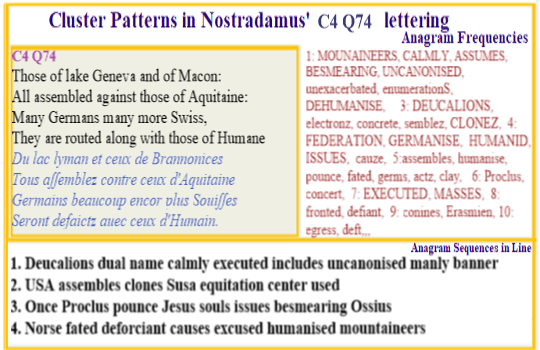 Analyses of all verses
Analyses of all verses
|
 Web Site
Web Site |
 All
Sefirots All
Sefirots |
Nostradamus C4 Q74: The debate behind the cloning of Jesus.
Copyright: Allan Webber, December 2015
 This verse is one of several that uses loose connections of related
words which the methods of Sephirot Coding then unifies.
This verse is one of several that uses loose connections of related
words which the methods of Sephirot Coding then unifies.
They are about ancient themes on the immortality of Gods and Jesus, and the relevance of these concepts in fuelling a war late in the 21st Century.
Verses C1Q62, C4Q70, C4Q72 and C4Q74 are part of this same jigsaw.
The anagrammatic keys of this verse lie in Ossius ( Souiſſ), executed ( et ceux de) uncanonised ( annonices Du), enumerations ( maine Seront), so Proclus pounce ( coup en - cor plus- So), besmearing Jesus's Souls ( lus So - uiſſes -Germains be).
There are six anagrams for Proclus in the Prophecies. This verse has great relevance to Proclus and his views. Many of the anagrams found in the second line have a quite powerful resonance with the views that philosopher held on the relationship of mortal body and soul to the immortal God(s).
Proclus himself often uses the term 'theology' in [a] metaphysical sense for the study of the first ('divine') principles of all things. His Elements of Theology can in fact be considered an introduction to his metaphysics. The work is a concatenated demonstration of 217 propositions, which may be divided into two halves: the first 112 propositions establish the One, unity without any multiplicity, as the ultimate cause of reality and lay down basic metaphysical concepts/structures such as causality, participation, the relation of wholes to parts, infinity, and eternity. The second half deals with the three kinds of true causes within reality recognized by Proclus: gods (which he calls henads or 'unities',...), intellects, and souls. This elaborate metaphysical framework makes it possible for Proclus to develop a scientific theology, i.e., a demonstration of the procession and properties of the different classes of gods... Stanford Encyclopedia of Philosophy